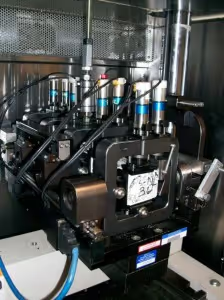Asphalt Binders, California vs. Nevada


What’s the difference?
California vs. Nevada Polymer-Modified Asphalt Binders:
by Roger Schlierkamp, PE
Caltrans and NDOT have each created polymer-modified asphalt binders that meet PG “plus” specifications that differ in their properties, but is there really a difference between the two? The California Department of Transportation (Caltrans) and the Nevada Department of Transportation (NDOT) use different polymer-modified asphalt binders. Since the implementation of the Superpave performance grade (PG) system, several state highway agencies, including Caltrans and NDOT, have experienced good performance with polymer-modified hot mix asphalt (HMA) mixtures and have created the PG “plus” specifications to enhance the performance of flexible pavement in harsh climates.
Caltrans uses a polymer-modified asphalt binder, PG64-28PM, in certain projects throughout the state. They use PG64-28PM polymer-modified asphalt binders with their dense-graded asphalt mixtures. The “PM” extension indicates that the binder meets the Caltrans PG “plus” specifications which include the standard Superpave PG system plus maximum phase angle on RTFO binder at the high critical performance temperature and elastic recovery on RTFO binder at 77°F. NDOT uses the polymer-modified asphalt binder PG64-28NV on all roadways in the northern part of the state. The “NV” extension indicates that the binder meets the NDOT PG “plus” specifications which include the standard Superpave PG system as well as properties such as toughness and tenacity on original binder at 77°F, ductility on original, and RTFO binder at 40°F.
In order to test their differences, the asphalt binders were supplied by two manufacturers, Paramount Petroleum Company and Valero Marketing and Supply Company. They each provided a blend of PG64-28PM and a blend of PG64-28NV asphalt binder.
The HMA mixtures were designed using the Marshall design method per the agency’s specifications. The optimum binder content was selected at 4% air-voids and then used to determine the corresponding values for Marshall stability and flow, VMA, and VFA for the appropriate relationships. The optimum binder contents were 5.0% by total weight of mix for all evaluated mixtures. The aggregate source was consistent for all mixtures, and the same gradation was used. Laboratory tests were then performed for the following modes of pavement failure: moisture damage, fatigue cracking, permanent deformation, and thermal cracking. The tests revealed interesting results. For moisture damage, the PM and NV binders displayed excellent resistance by displaying excellent stiffness after 6 freeze-thaw cycles. For fatigue cracking, the NV binder displayed significantly better resistance under repeated flexural bending. For permanent deformation resistance, the NV binder exhibited more stability. Lastly, for thermal cracking resistance, the NV binder displayed the lowest fracture temperature and intermediate level of fracture stress, making it more resistant to thermal cracking compared to the PM binder.
The results of the laboratory tests show that the two different binders are in fact different. The PM mixture was not as stable as the NV mixture. Although the majority of California does not experience the extreme temperatures that Nevada does, it is important to be familiar with other products and standards. We are now aware of this other binder should we come across a situation where this binder would be beneficial to use.
Reference: Hajj, Elie Y., Sebaaly, Peter E., Schlierkamp, Roger W., Cortez, Edward. “Laboratory Evaluation of PG64-28PM Polymer-Modified Asphalt Binders.” Western Regional Superpave Center. January 2011.
Roger Schlierkamp, MSc, PE, is Director of Pavement Engineering at GMU Geotechnical.




%20(1).png)
